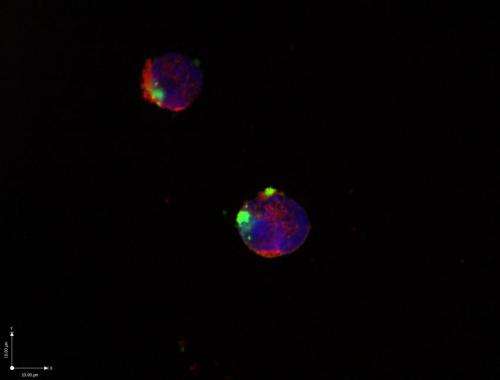Researchers engineer a 'smart bomb' to attack childhood leukemia

Fatih Uckun, Jianjun Cheng and their colleagues have taken the first steps towards developing a so-called "smart bomb" to attack the most common and deadly form of childhood cancer—called B-lineage acute lymphoblastic leukemia (ALL).
In a November study in the new peer-reviewed, open-access journal EBioMedicine, they describe how this approach could eventually prove lifesaving for children who have relapsed after initial chemotherapy and face a less than 20 percent chance of long-term survival.
"We knew that we could kill chemotherapy-resistant leukemia cells if we only knew what made them so resistant. Once we determined the mechanism, the next step was obvious—to rationally design a drug that would take out that specific target," said Uckun, professor of research pediatrics at the Keck School of Medicine of USC and head of translational research in leukemia lymphoma at the Children's Center for Cancer and Blood Diseases of Children's Hospital Los Angeles.
The target of the "smart bomb" is a defective gene that results in the production of an abnormal form of the protein CD22, which causes cancer stem cells to proliferate and resist chemotherapy. This defective gene can thwart standard treatments for recurrent disease—including "supralethal" chemotherapy, total-body irradiation (TBI) and bone marrow transplantation.
Uckun's team designed synthetic pieces of genetic material, called RNAi, with the capability to shut down this defective gene. Then Uckun joined forces with Cheng, associate professor of materials science and engineering at the University of Illinois at Urbana-Champaign and an affiliate with the NCI Alliance for Nanotechnology in Cancer. Cheng's team engineered a small subunit of protein, called a polypeptide, to function as delivery system to send the RNAi to its target.
The resulting "smart bomb" has a diameter of only 100 nanometers, making it one of the new generation of nanomedicines that can target disease at a molecular level.
"The goal is to translate our recent research discoveries in nanotechnology and biotherapy into effective patient-tailored treatment programs for the most common form of childhood cancer," said Uckun, who is also a principal investigator with the university-wide USC Stem Cell initiative, bringing together more than 100 faculty members from all disciplines.




















